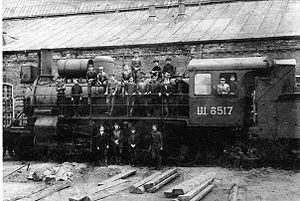Russian series Щ
| Russian series Щ | |
|---|---|
|
Zhch-6517
|
|
| Numbering: | different numbering |
| Number: | 1.910 |
| Manufacturer: | Kharkov , Bryansk , Lugansk , Nevsky , Putilov , Sormowo , Kolomna |
| Year of construction (s): | 1906-1918 |
| Retirement: | Late 1950s |
| Axis formula : | 1'D h2v 1'D h2 |
| Gauge : | 1,524 mm |
| Length: | 11,701-11,753 mm |
| Empty mass: | 69-71.2 t |
| Service mass: | 77.3-78.3 t |
| Friction mass: | 64.2-64.7 t |
| Wheel set mass : | 16 t |
| Top speed: | 75 km / h |
| Indexed performance : | 620 hp |
| Driving wheel diameter: | 1,300 mm |
| Impeller diameter front: | 930 mm |
| Control type : | Heusinger |
| Number of cylinders: | 2 |
| Cylinder diameter: | with simple steam expansion: 590 mm |
| HD cylinder diameter: | 510 mm, 540 mm |
| LP cylinder diameter: | 765 mm |
| Piston stroke: | 700 mm |
| Boiler overpressure: | 12-14 bar |
| Number of heating pipes: | 24-27 |
| Number of smoke tubes: | 272.176 |
| Grate area: | 2.8 m² |
| Superheater area : | 40.9-59 m² |
| Evaporation heating surface: | 168.9-176.7 m², 206.1 m² |
| Particularities: | Locomotive built as a compound steam engine and as a simple two-cylinder engine |
The Russian class Щ (German transcription Shcha) was a steam locomotive of the Soviet Railways (SŽD) in Russian broad gauge . It had been procured in large numbers in the Russian Empire and was considered a versatile steam locomotive on non-electrified lines. It was named after Nikolai Leonidowitsch Shchukin .
prehistory
Around 1905, as a result of the Russo-Japanese War, there was a need on the railways of the Russian Empire for more powerful freight locomotives than the O series . During this time, the state railways began to replace worn rails and those of the light type with heavier types. In this context, it made sense to build a more powerful and heavier steam locomotive. In 1905, the future Minister of Transport, Shchukin, was commissioned to build a new type of freight locomotive.
Regardless of the fact that several types of steam locomotives with the E- wheel arrangement were already in service on the railways in Europe , Shchukin opted for the restricted type with type 1'D . The reason for this decision was possibly the expected higher speed. He borrowed ten Ш series locomotives from the Chinese Eastern Railway and tested them on the Katharinen Railway . This led to the development of the new type of steam locomotive by the Kharkov locomotive factory .
Design and construction
The technical office of the Kharkov locomotive factory, headed by engineer Alexander Rajewski , then designed a steam locomotive with a two-cylinder compound machine and a 1'D wheel arrangement. The technical data shows that locomotives were also built with a simple two-cylinder design. In the same year the workshop built a prototype locomotive under the designation Ю х 3501 and used it for test drives on the Katharinenbahn. In 1912 the locomotives of this project were given the designation Щ after Shchukin.
A total of 1910 locomotives of this series were delivered from 1906 to 1918. All plants of the association of the Russian steam locomotive manufacturing company manufactured the new locomotive. In 1911 some examples were made in the Black Sea Shipbuilding Company in Mykolaiv .
business
The new steam locomotives were used on the South-East Railway and North-Donetsk Railway and ran there at the beginning of the 20th century on routes such as Popasna - Kupyansk , Rostov-on-Don - Ilovaisk , Mariupol - Wolnowacha - Donetsk - Avdiivka - Chapline - Synelnykowe - Dnipropetrovsk - Pjatychatky , Muschketowe - Jassynuwata , in the area of Kiev , Odessa , Belgorod , Kursk , - Kharkiv - Ivangorod - Moscow and Yekaterinburg .
When the train loads increased significantly on these routes, they were replaced on routes with a lighter profile, such as Leningrad - Moscow, by locomotives with twice the power ( Э , Е ). The performance of the locomotives was no longer in accordance with the needs, the advantage of the locomotive was the higher speed. The axle load was 16 t, which made it freely usable.
With the arrival of more newer machines, they were released for service on less frequented routes, where they served until the early 1950s. After the arrival of diesel locomotives of all performance classes, they were parked as a reserve. At the end of 1950 they began to be phased out. The last machine is said to have been taken out of service in 1961. There are said to have been a few locomotives in reserve service in the 1980s.




